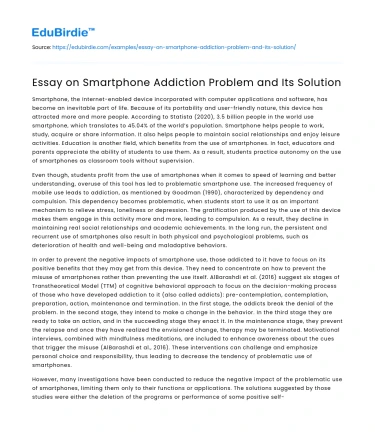Smartphone, the Internet-enabled device incorporated with computer applications and software, has become an inevitable part of life. Because of its portability and user-friendly nature, this device has attracted more and more people. According to Statista (2020), 3.5 billion people in the world use smartphone, which translates to 45.04% of the world’s population. Smartphone helps people to work, study, acquire or share information. It also helps people to maintain social relationships and enjoy leisure activities. Education is another field, which benefits from the use of smartphones. In fact, educators and parents appreciate the ability of students to use them. As a result, students practice autonomy on the use of smartphones as classroom tools without supervision.
Even though, students profit from the use of smartphones when it comes to speed of learning and better understanding, overuse of this tool has led to problematic smartphone use. The increased frequency of mobile use leads to addiction, as mentioned by Goodman (1990), characterized by dependency and compulsion. This dependency becomes problematic, when students start to use it as an important mechanism to relieve stress, loneliness or depression. The gratification produced by the use of this device makes them engage in this activity more and more, leading to compulsion. As a result, they decline in maintaining real social relationships and academic achievements. In the long run, the persistent and recurrent use of smartphones also result in both physical and psychological problems, such as deterioration of health and well-being and maladaptive behaviors.
Save your time!
We can take care of your essay
- Proper editing and formatting
- Free revision, title page, and bibliography
- Flexible prices and money-back guarantee
In order to prevent the negative impacts of smartphone use, those addicted to it have to focus on its positive benefits that they may get from this device. They need to concentrate on how to prevent the misuse of smartphones rather than preventing the use itself. AlBarashdi et al. (2016) suggest six stages of Transtheoretical Model (TTM) of cognitive behavioral approach to focus on the decision-making process of those who have developed addiction to it (also called addicts): pre-contemplation, contemplation, preparation, action, maintenance and termination. In the first stage, the addicts break the denial of the problem. In the second stage, they intend to make a change in the behavior. In the third stage they are ready to take an action, and in the succeeding stage they enact it. In the maintenance stage, they prevent the relapse and once they have realized the envisioned change, therapy may be terminated. Motivational interviews, combined with mindfulness meditations, are included to enhance awareness about the cues that trigger the misuse (AlBarashdi et al., 2016). These interventions can challenge and emphasize personal choice and responsibility, thus leading to decrease the tendency of problematic use of smartphones.
However, many investigations have been conducted to reduce the negative impact of the problematic use of smartphones, limiting them only to their functions or applications. The solutions suggested by those studies were either the deletion of the programs or performance of some positive self-fulfilling activities. According to AlBarashdi et al. (2016), in the TTM approach the addicts themselves become their own therapists, developing their own awareness and making strong decisions that result in the modification of behavior.
The TTM approach, combined with mindfulness meditation, seems to be a good solution against the problematic use of smartphones.






 Stuck on your essay?
Stuck on your essay?

